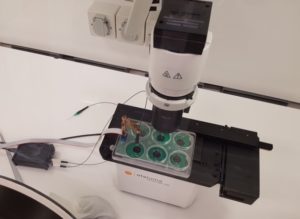Lumascopes
Applications: Microfluidic Microscopes and Co-Culture Complexity
“For the first time, experimental conditions capable of reproducibly forming diverse microvascular networks from telomerase immortalized endothelial and mesenchymal stem cells in both 2D and 3D hydrogel-embedded cultures are reported.”
Etaluma’s Microfluidic Microscope Imaging
From one of our favorite labs—Mark Allenby and the team at the BMSE Lab at University of Queensland—a new paper that really hits the sweet spot of biology and bioengineering. They’ve pulled off something tricky: reproducible formation of microvascular networks and adipocyte differentiation, in the same 3D hydrogel co-culture, using immortalized human cells. That’s a big deal.
It’s all built around a clever microfluidic design that creates counter-current gradients of vasculogenic and adipogenic cues. The result? Vessel networks that don’t just form, but stick around long enough to matter. Adipogenesis that doesn’t need a dozen differentiation steps. And enough live-cell imaging to make our microscopy hearts happy.
Speaking of which—this all comes with some very nice time-lapse footage captured on the Etaluma LS720 (LS820 is our latest model).
At a 1:5 seeding ratio, you get networks that hold together through 7 days of culture. Higher ratios (2:1, 1:1) formed quickly but lifted off the plate. Lower ratios like 1:2 and 1:10 stuck around and produced stable, branching networks.
The microfluidic microscopy setup really shines here—not just for imaging, but for enabling spatiotemporal control over growth environments. It’s hard to model adipo-vascular crosstalk without the right gradients. This system nails it, with lipid coverage hitting 67% in co-culture, versus less than 2% in monoculture.
Super cool work. Full paper here: Murphy, Franco, and Allenby – https://onlinelibrary.wiley.com/doi/full/10.1002/smll.202501834
See Other Use Cases and Features of our Lumascopes
Live cell imaging
See Etaluma – Cardiac Myocytes Undergoing Division
Cell growth and confluence
See Time Lapse Video of MSC in 2D Cell Culture
Cell migration and wound healing
See Cell Migration & Wound Healing Application Note
See Migration of MSC in 2D Cell Culture
Cell cycle protein expression
See Human HT1080 Fibrosarcoma Cells with LS600
Use of micro-environmental systems
See Bioptechs products on Etaluma LS500
Calcium assays
GCAMP5 activity in a sensory neuron
Determining transfection efficiency
In Vitro Exercise Model
 Cultured skeletal muscle myotubes are electrically stimulated under hypoxic conditions and with temperature manipulations. Cell signal transduction dynamics are measured using proteomic techniques to help understand how exercise stressors are translated into fitness-promoting adaptions such as increased mitochondria. Probe in photo measures PO2 in the cell medium rather than in the atmosphere. LS620 allows visualization of contracting cells and assessment of their health.
Cultured skeletal muscle myotubes are electrically stimulated under hypoxic conditions and with temperature manipulations. Cell signal transduction dynamics are measured using proteomic techniques to help understand how exercise stressors are translated into fitness-promoting adaptions such as increased mitochondria. Probe in photo measures PO2 in the cell medium rather than in the atmosphere. LS620 allows visualization of contracting cells and assessment of their health.
Thank you to Dr David Clarke and his lab, Laboratory for Quantitive Exercise Biology, Simon Fraser University, British Columbia, Canada
Behavior of stem cells
See Etaluma-Human Neural Stem Cells in Culture 1
See Etaluma-Human Neural Stem Cells in Culture 2
Also see reattachment of neuronal stem cells passaged with Accutase (scroll down to see video)
Cell death assays
Apoptosis induction
Spheroid development and behavior
See 3D Spheroid Formation of MSC
See Spheroid-Migration of MSC in a PEG-Fibrinogen Hydrogel
Cultivation of yeast
See Cultivation of S. cerevisiae in Core-Shell Microcapsules
Intravital studies
See Series: Neutrophil migration intravital mouse imaging
Study of lower eukaryotes
Photomicroscopy in locations without AC power
Copyright © 2024 Etaluma, Inc. All rights reserved.
